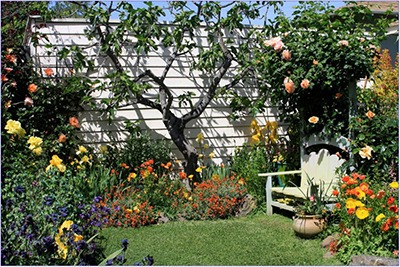Whether you are doing your own landscaping or employing a professional designer/landscaper, these “basics” can help you in the process.
What is your “Dream Scene”? What is it you want to see when you look out of your windows or when you drive up to your house?
Photographs can be an enormous help in designing your landscape. When you see a planted area that appeals to you, take a photo. When you see a magazine picture of a beautiful landscape, save the photo.
Get ideas from online sites that feature different types of landscapes. Photographs help to “set the scene” and visually convey your ideas to your designer/landscaper or to the nurseryman when purchasing plants.
Things to keep in mind when choosing plant varieties:
• What are your expectations for spring, summer, fall and winter?
• Do you want fast- or slow-growing plants?
• What are your height requirements or restrictions?
• What are your color preferences?
• What textures do you prefer?
Right plant, right place
Select plants that are appropriate to your climate zone and to your specific site orientation. Take these conditions into account:
• average monthly rainfall
• maximum and minimum temperatures
• length of growing season
• wind exposure
• hours of sun and shade
• eventual plant size and shape
Consider your lifestyle and what is needed to support your interests:
• Purely practical — parking, garage, general storage, garden tools and equipment, trash and recycle cans, A/C and heat pump, firewood, recreational equipment
• Entertaining — style, setting, equipment/facilities needed
• Recreation — sports, hobbies, related tools, facilities, storage
• Relaxation — hot tub, quiet/meditative area
• Gardening — areas for growing vegetables, berries, fruits
Specifics
The following “site specific” items may influence how much of your Dream Scene can be achieved and the budget required:
• Existing trees and structures
• Boundary lines, set backs, easements, covenants and restrictions
• Slope of property — gradient/drainage
• Downspouts and drain systems
• Utility lines including distribution points
• Relation of house and proposed landscaping to adjacent property and traffic
• Wild animals that share the area
Determine your landscape budget for design, infrastructure, plants and maintenance. In addition to the cost of plants your budget might include removal of trees, building terraces, moving/removing/adding soil, installation of a drainage system, installation of a watering system.
Establishing the appropriate infrastructure is the difference between a landscape that survives for a few seasons and one that matures and provides beauty over many years.
When is the best time to start your landscape project? Planning and infrastructure can be done at nearly any time of the year. In the Pacific Northwest the most favorable time to plant is early spring or early fall when cool, moist conditions are most favorable to the flowers, shrubs and trees. The references provided in the sidebar (at right) address both general and specific information.
A well-executed landscape design can add curb appeal and monetary value to your property.
But perhaps more importantly, a beautiful landscape adds emotional and psychological value to your everyday environment.
Is it time to begin creating your “Dream Scene”?
Helpful references for your ‘Dream Scene’
“The Encyclopedia of Ornamental Grasses” by John Greenlee and Derek Fell
“Handbook of Northwestern Plants” by Helen M. Gilkey and La Rea J. Dennis
“Japanese Maples” by J.D. Vertrees
“Northwest Trees” by Stephen F. Arno and Ramona P. Hammerly
“The Pacific Northwest Gardener’s Book of Lists” by Ray and Jan McNeilan
“Perennials for Washington and Oregon” by Alison Beck and Marianne Binetti
“Plants of the Pacific Northwest Coast” by Jim Pojar and Andy MacKinnon
“Right Plant, Right Place: The Indispensable Guide to the Successful Garden” by Nicola Ferguson
“Sunset Western Garden Book” by Sunset Publishing Company
“Washington and Oregon Gardener’s Guide” by Debra Prinzing and Mary Robson
Judy English is a Washington State University-certified, Clallam County Master Gardener.


